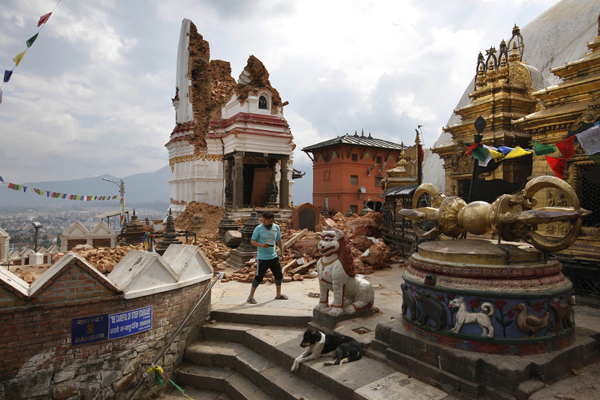 |
|
In this April 30, 2015 photo a man walks through the famous Swayambhunath stupa after it was damaged in the April 25 massive earthquake in Kathmandu, Nepal. [Photo/IC] |
Amrit Sharma, an Indian national who grew up in Kathmandu and has spent much of his life here, said the tower was like "our Washington Monument, our Empire State building."
"The damage to these sites is not just a huge loss for Nepal, it's a huge loss for humanity," Sharma said. "People come from all over the world to see these. But they're not just tourist attractions to us. If we lose them, we lose a sense of our past."
Among the worst hit sites was Kathmandu's historic center, Basantapur Durbar Square. Built between the 12th and 18th centuries, it is a place where kings have been coronated and religious festivals are held. The Nepal Archaeology Department website calls it "an open museum of Nepalese culture, art and architecture."
Steps that once led to a pair of pagoda-style Hindu temples with multi-tiered roofs now lead nowhere, resembling giant anthills. One of them, Kasthamandap, was built five centuries ago and is believed to have been constructed from the timber of a single tree.
Elsewhere, a 17th century statue of Garuda, a bird-like deity in Hinduism ridden by the god Vishnu, lies at the bottom of a tall stone pillar it once adorned. Other temples have been leveled completely.
Although soldiers and police guard the sites, hundreds of residents freely clambered over the top of some ruins, as well as piles of brick and intricately carved wood. Many were helping in a preliminary effort to clean up the site.
Laxmi Rimal, 18, had slept on a wooden pallet under a blue tent in the square since the earthquake. "Our house was completely destroyed, it looks like that," she said, gesturing toward the crumbling white plaster edifice of Gaddi Durbar, which was built in 1908.
At the Swayambhunath stupa, a Buddhist site also venerated by Hindus and known to tourists as "the monkey temple" for its resident population of primates, police wave visitors away. The 365 stone steps leading up to it, each representing a day of the year, are blocked off with debris.
Inside, shopkeepers and monks were shaking dirt from books, Buddha statues and relics they had dug out of the rubble of a monastery which had partially collapsed onto a shop. Supendra Buddhacharya, who sold tourist curios there, lamented what he predicted would a major drop in tourism nationwide if the sites are not rebuilt swiftly.
"If we don't have heritage here, what will people come to Kathmandu to see?" he asked.
Legend has it that a sage sowed a lotus seed in a beautiful lake that existed where the stupa now stands. The seed blossomed with thousand petals, and from that flower a dark-blue flame emanated, which came to be known as Swayambhu joti, or "self-originated flame," which gave the site its name.
On Wednesday, Lama Zoba, a Buddhist monk, stood before the temple's white dome. The eyes painted on the gold spire above it – symbolizing the omniscient, all-seeing nature of Buddha – peered in four directions across the valley. The view is stunning and peaceful, but it belies the tragic fact that bodies are still being dug out of the rubble below.
"You can't compare this loss to the loss of human life. But you can't bring back the dead, they are gone," Zoba said. The temple, though, "will be rebuilt. And we will use it to pray for their next lives."